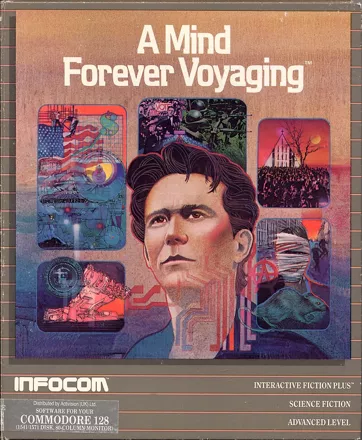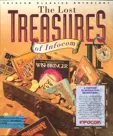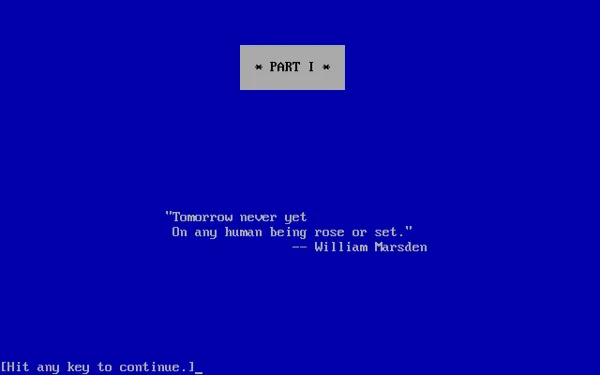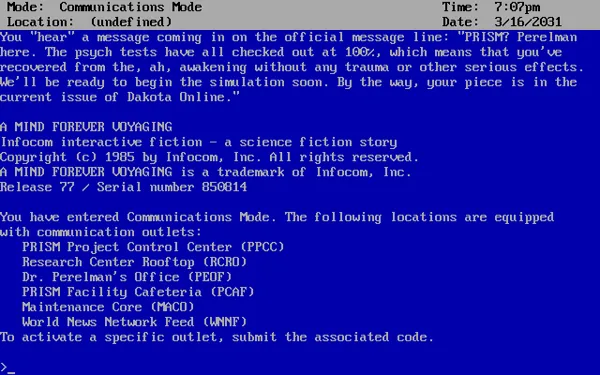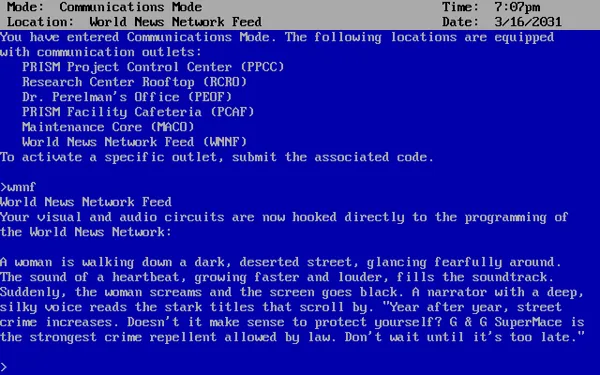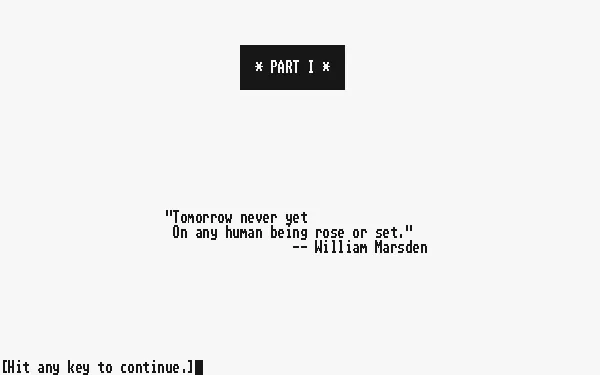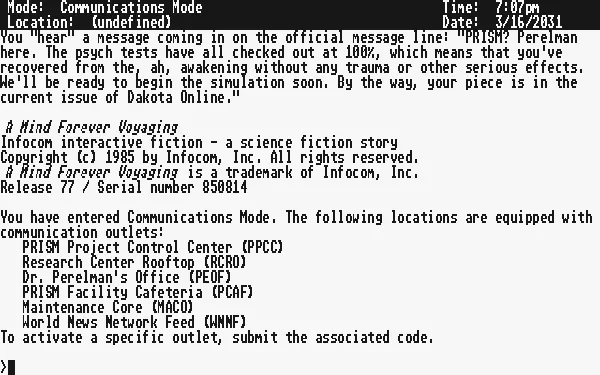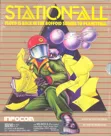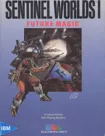A Mind Forever Voyaging
Description official descriptions
The year is 2031 and the world is near the brink of economic collapse. To avoid this, the president comes up with a plan to stop the disaster - but before applying it, the long-term impacts on the world need to be validated. This is done with a simulation visited by the computer project PRISM, designed to be a true AI. The game starts when PRISM awakes from a simulation of his own, human life and is told that he is in fact the world's first sentient machine. At this point, the player takes control over PRISM.
A Mind Forever Voyaging is a text-based interactive fiction game. The player reads descriptions which detail the surroundings and communicates with the game by typing in commands. Most of the time is spent in simulation mode where the player repeatedly visits the town of Rockvil and needs to record situations of everyday or special activities going on. If the player has recorded enough, the game progresses and the simulation ten years ahead can be visited. However, the recording device has no unlimited capacity - when full, the player needs to exit the simulation and let the recordings review by the project leader. Then the current simulation can be simply started again from the start to find new situations - the same applies when dying.
Between simulations and toward the end there are situations outside the simulation, but overall the game is light on puzzle-solving and more about experiencing how said plan changes Rockvil and its people over time. Outside the simulation there are three more modes to enter: communications (switching to various video/audio units to examine other locations and people), library (various documents and other information to read) and interlace (communicating and giving orders to the own subsystems).
Groups +
Screenshots
Credits (DOS version)
21 People
| Design | |
| Development tools for Interactive Fiction Plus | |
| Help from | |
| Playtesting | |
| Various Wizardries on the Micro-Computers | |
| Package Design by | |
| Package Art | |
| Photography | |
| Advice and Support |
Reviews
Critics
Average score: 80% (based on 7 ratings)
Players
Average score: 3.9 out of 5 (based on 59 ratings with 5 reviews)
The Good
The story was a gritty, interesting "projection" about what could happen when something that looks too good to be true is.
This is Infocom's most adult story/game with a serious tone, a departure from Steve M's well-known humor.
The Bad
There wasn't any GAME! You just wandered from sequence to sequence, observing. At the end, there was some kind of puzzle, but not much. I never understood why it was rated Advanced.
The Bottom Line
A neat concept for an interactive novel, but with little interaction.
DOS · by Tony Van (2796) · 1999
The game that defines the concept of adventure gaming.
The Good
What is the adventure gaming about? What is the underlying principle that should be present in all the adventure games without any exception? Inventory puzzles, myst-like puzzles, point’n’click interface, branched dialogue trees? No. The answer to these questions is deceptively simple. Exploration and interaction. If you’re given ability to explore the virtual surrounding and interact with it on many levels, than it’s an adventure game. If not, then it’s something else, probably a F22 flight simulator. What I’m trying to say is that adventure game isn’t about puzzles at all. Puzzle in an adventure game is just a necessary evil, designed to make up for the lack of challenge otherwise. That actually became one of the reasons of unfortunate demise of adventure genre in the late nineties. The issue has been addressed many times since. Fahrenheit, Shenmue, Dreamfall, Gabriel Knight 3 all of these games offered their versions of puzzle-less adventure game with a variable success. But the answer has been already given a long time ago, back in 1985. In the form of the game called A Mind Forever Voyaging.
Here’s a little story background for those unfamiliar with the game. In the AMFV you take role of PRISM, a sentient computer capable of exploring virtual reality and reporting back to people maintaining it. It seems that in the world of near future the government has run into some problems with the country. Crime levels elevated, people lose their jobs, all in all the usual kind of stuff. So government officials come up with something called - The Plan. A 20 years development plan that’ll let the country to overcome its difficulties and create a perfect society. Utopia? Maybe, that’s why you’re here. Scientists have recreated a generic American town inside a computer and applied The Plan to its development course. Your task is to investigate what it’s like living in that town in 10 years from now, 20 years and so on. First you’re given list of things to do by the scientists – eat in the restaurant, buy food from the grocery store, take a subway ride etc. Then they leave it on your discretion. You’re alone is deciding what relevant or not, what will be help to the people of tomorrow or what will hurt them. As more of the time periods become available you’ll see that some things are not exactly what they seemed to be. Well that covers it up, now to the review itself.
Text adventures have always been in a way superior to their graphical counterpart. Whereas graphic adventures are always limited by the current technology level, text adventures are only limited by the power of player’s imagination. So creating big and immersive life-like reality is a task that only a text adventure is capable of, at least now in 2007. And AMFV uses that advantage to its fullest capacity. A handful of completely different towns (while staying essentially the same town but in different time periods) with a lot stuff to do, things to notice, events to experience, facts to investigate and without any restriction from developers is simply a joy. That kind of freedom makes you drunk. You can literally do whatever you want. I know that this kind of sentence has been applied too many times to different games, but it can’t be more truthful than in a case of AMFV. Here’s an example. You as a game character have a wife; you can visit her in the town you’re exploring in the first 10 or 20 years. And you will undoubtedly get really attached to her. So when you visit her sometime later it will really break your heart to see what’s happening to her. Damn! It’s so hard to explain without spoilering. What I mean is that you could not visit your wife at all, and still complete the game. Now that is an adventure, experiencing things in a way you want them to experience in the context of the story and setting created by the developers
And what’s the most brilliant is that everything is so credible and realistic. You’re always in the game; you don’t go “OMG! What a blurry texture? How could they leave it in so otherwise quite a perfect game?” You don’t have to suspend your disbelief, because there is none. The graphic adventures unfortunately are still not capable of that kind of immersion.
The game is bundled (ah… those Infocom bundles) with a wonderful science fiction preface story that is so good, that I wonder why it hasn’t received a Hugo award or something. Be sure to read it before getting into the game. Heck! Read it even if you’re not going to play the game at all. It is a really fascinating read.
The Bad
Well the usual text adventures problems apply here as well. Tiresome interface, awful conversation system, lots of text (that’s unexpected) and so on. There’s actually one of the more common types of puzzle late in the game, but it’s only one and not that hard. Also I wish they would have done mode changing a trifle easier. It certainly eats a lot of time just to enter into a town reality.
The Bottom Line
Otherwise, a perfect a game! If the other video games were more like it, they could’ve achieved that art status they’re desperately seeking a long time ago. Undoubtedly AMFV is one of the best adventures up to date with hardly a single puzzle in it. If you’re going to play only one interactive fiction game in your lifetime, make sure it’s A Mind Forever Voyaging.
DOS · by St. Martyne (3648) · 2007
It's Interactive Fiction, plus
The Good
A Mind Forever Voyaging (AMFV) is another text adventure from Infocom, but it's slightly different from the company's text adventures that I played during the years such as Zork. It is the first of the “Interactive Fiction Plus” line, meaning that the game has greater memory requirements. However, in my opinion, it also means that the mechanics are different and that there is one instance of graphics.
In the year 2031, a sentient machine, known as PRISM, has lived an artificial life. It wasn't until your twentieth birthday that you find out that you are actually a computer designed to enter a simulated world in the future, see how society will be influenced by “The Plan”, and report your findings to the government so they can determine if it is worth implementing. Under “The Plan”, the future scenario may be idyllic, but you sense that something is wrong; and as time passes, you feel that you should be doing more than just sightseeing.
You are given five modes which you can use, with the majority of the game spent in “Simulation Mode” where you witness the events around you and record them, and present these recordings in “Communications Mode”. The commands that you enter at the keyboard can be short or complex to the point where you can specify two actions you want to make.
In Sim Mode, you can select what year into the future you want to view (in increments of ten) and what's great is that the future is different every time you visit. In each of the simulations, you have an apartment in the peaceful city of Rockville, South Dakota. You also have a loving family and there is no threat to them. Within the next forty years, the same apartment is raided by the Border Security Force who are looking to stamp out illegal immigrants, one of your children is converted to the Church of God's Hand, and the entire city begins to deteriorate.
What's also neat about AMFV is the way this is the first Infocom game I have played to use copy protection. Every time you try to enter Sim Mode, you have to refer to the Class One Security Mode Access Decoder that comes in the box. The Access Decoder is a code wheel similar to that use with The Secret of Monkey Island, and the game cannot be completed without it. Also, I noticed one instance of graphics when you have to go through a test earlier in the game.
Each copy of AMFV comes with the game disks and manual, as well as Dakota Online Magazine, a full-color map of Rockvil, a pen, and the aforementioned Access Decoder. Inside Dakota Online is a story about how PRISM came to be, and a couple of reviewers on here have been bragging about how excellent this is. I also recommended reading this story before playing the game. If you have an illegal copy, you will miss the joys of having all these freebies.
The Bad
The only thing I didn't like was waiting a long time for a new simulated year to become available, even after you completed the previous ones. I had to wait two whole days before I could complete 50-year sim. Infocom could have made sims available when certain conditions were met, and one of these could have been that you have to do one or more sims that had been given to you earlier.
The Bottom Line
A Mind Forever Voyaging is a more advanced Infocom adventure where you take control of a computer sent to witness the effects of “The Plan” in a simulated future, and report your findings to the government. It is one of the titles in the IF+ line, due to the fact that requires more memory and that the game mechanics are quite different. Also, like any Infocom game out there, AMFV comes complete with “freelies”, and these are worth having even if you don't have any plans to play this game.
Amiga · by Katakis | カタキス (43086) · 2016
Trivia
1001 Video Games
A Mind Forever Voyaging appears in the book 1001 Video Games You Must Play Before You Die by General Editor Tony Mott.
Extras
A Mind Forever Voyaging contained a copy of "Dakota Online Magazine"; a map of Rockvil, South Dakota; a yellow pen ("Quad Mutual Insurance"); and a Class One Security Decoder (used for copy protection). As of 2004 it was reported that the pen still is in working condition.
References
The man on the cover looks like a young Timothy Hutton.
Awards
- GameSpot
- December 17, 1999 - 2nd Best Ending in PC Gaming History (Editors' Vote)
Information also contributed by Maw and James Evans, WizardX
Analytics
Upgrade to MobyPro to view research rankings and price history! (when applicable)
Related Sites +
-
Crapshoot
A humorous review on PC Gamer -
Infocom homepage
At this site you can find information on ALL of Infocom's interactive games, Infocom related articles, sample transcripts, InvisiClue hints, walkthroughs, maps and information on buying Infocom games today. -
The Commodore Zone
All about the game with introduction, images, related links and comments area. -
The Infocom Gallery
High-quality scans of the grey box package and manual of A Mind Forever Voyaging.
Identifiers +
Contribute
Are you familiar with this game? Help document and preserve this entry in video game history! If your contribution is approved, you will earn points and be credited as a contributor.
Contributors to this Entry
Game added by Brian Hirt.
Commodore 128 added by Corn Popper. Apple II added by Droog. Amiga, Macintosh added by Terok Nor. Atari ST added by Belboz.
Additional contributors: Dietmar Uschkoreit, Belboz, Adam Baratz, xofdre, Pseudo_Intellectual, mo , c64fan, Patrick Bregger, FatherJack.
Game added March 10, 1999. Last modified May 23, 2024.


